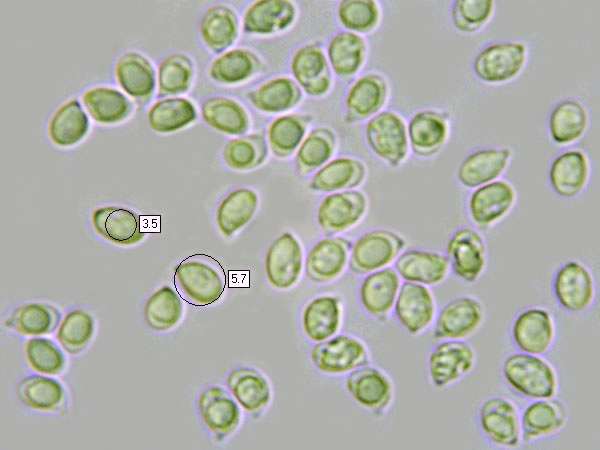Tricholoma saponaceum (Fr.) P. Kumm. - Soapy Knight
Phylum: Basidiomycota - Class: Agaricomycetes - Order: Agaricales - Family: Tricholomataceae
Distribution - Taxonomic History - Etymology - Identification - Culinary Notes - Reference Sources
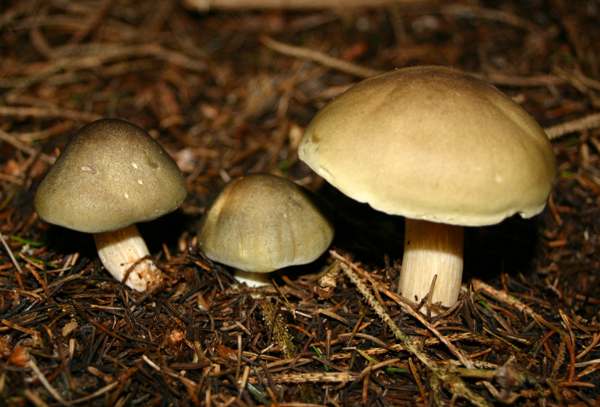
Few tricholomas have truly descriptive common names, but the Soapy Knight, Tricholoma saponaceum has an odour of soap suds and thoroughly deserves the common name it has been given. That its soapy smell is so distinctive is a great help to fungus forayers, because the physical form and the colours of this woodland mushroom are very variable indeed.
An easy agaric to spot in coniferous and broad-leaf forests, Tricholoma saponaceum appears in autumn, sometimes forming large groups (below).
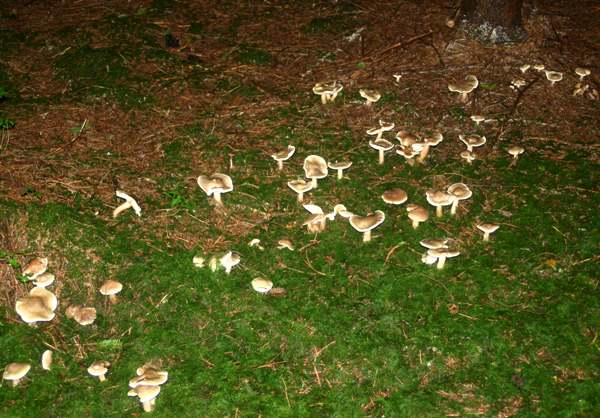
Distribution
This woodland mushroom is fairly common and widespread throughout Britain and Ireland, and it occurs also in most parts of mainland Europe. Tricholoma saponaceum is also recorded in North America.
Taxonomic history
Although this mushroom was described scientifically by Christiaan Hendrik Persoon in 1801, its basionym dates from 1818 when the great Swedish mycologist Elias Magnus Fries gave it the name Agaricus saponaceus. (In those days most gilled mushrooms were included initially in the genus Agaricus; the vast majority of them have since been redistributed to many other genera.) Several varieties of the Soapy Knight are recognised, and the nominate form shown here is Tricholoma Saponaceum var. saponaceum.
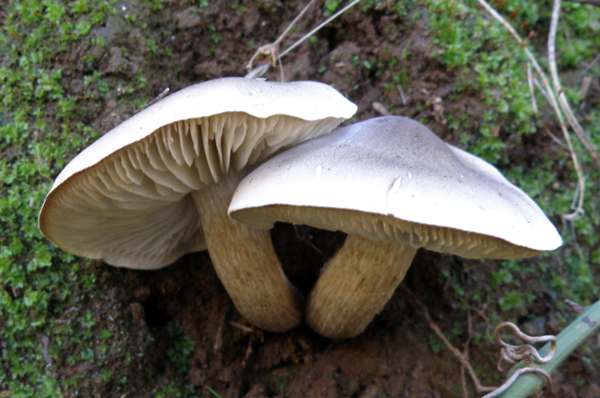
Synonyms of Tricholoma Saponaceum var. saponaceum include Agaricus atrovirens Pers., Agaricus saponaceus Fr., Agaricus napipes Krombh., Tricholoma saponaceum (Fr.) P. Kumm., Tricholoma saponaceum var. atrovirens (Pers.) P. Karst., and Tricholoma saponaceum var. napipes (Krombh.) Barla.
Tricholoma Saponaceum var. squamosum (Cooke) Rea is a much rarer find in Britain and Ireland; it differs in having a very dark grey-brown cap (almost black in some instances) and dark scales also on the stem; but the soapy odour is just as obvious as in the nominate variety. (The specimens shown on the left might be Tricholoma saponaceum var. squamosum.)
This variety of the Soapy Knight was described originally in 1884 by British mycologist Mordecai Cubitt Cooke, who gave it the name Agaricus saponaceus var. squamosus.
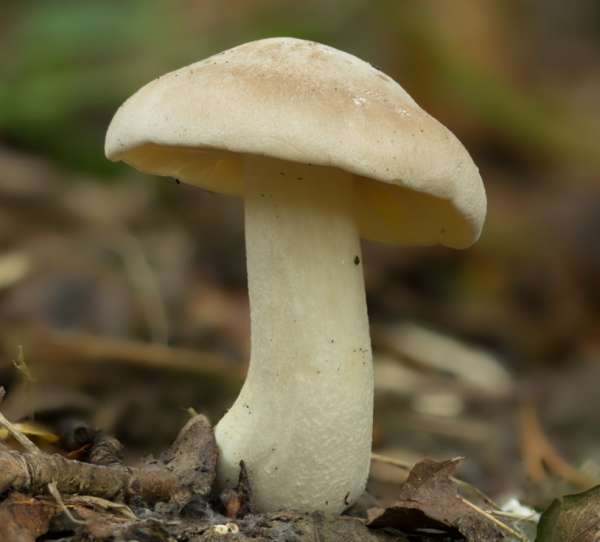
Etymology
Tricholoma was established as a genus by the great Swedish mycologist Elias Magnus Fries. The generic name comes from Greek words meaning 'hairy fringe', and it must be one of the least appropriate mycological genus names, because very few species within this genus have hairy or even shaggily scaly cap margins that would justify the descriptive term.
The specific epithet saponaceum comes from Latin and is a reference to the soapy smell that is given off when the gills are crushed.
Identification guide
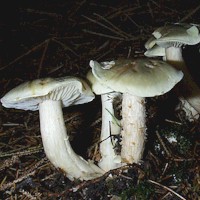 |
Also referred to as the Soap-scented Tricholoma, this is a woodland mushroom that quite often produces small tufted groups, as shown here. |
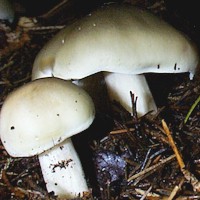 |
CapUp to 12cm in diameter when fully mature, the very variable caps are usually greyish or greenish-grey in the centre but with a paler, often with an almost pure-white edge. Initially convex, the caps flatten, sometimes with a slight umbo, and the margins become wavy, sometimes flaring very irregularly. |
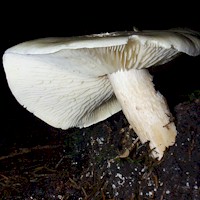 |
GillsSinuate and well spaced apart, the gills are white but take on a reddish tinge a short time after being bruised. StemTypically 10 to 20mm in diameter, the stem is white and covered with small light-grey fibres. This is a deep-rooting species. |
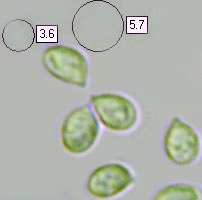 |
SporesEllipsoidal, smooth, 5-7 x 3.5-4μm; inamyloid. Spore printWhite. |
Odour/taste |
Strong odour of (naturally-scented!) soap when the gills are crushed or cut; taste is 'mushroomy'. (Note: this is an inedible and possibly poisonous species.) |
Habitat & Ecological role |
Ectomycorrhizal, in broadleaf and coniferous woodland. |
Season |
June to October in Britain and Ireland; rather later in soutern Europe.. |
Similar species |
Tricholoma terreum is sometimes pale capped and then it can be quite similar to Tricholoma saponaceum in appearance, but it does not have the distinctive soapy smell. |
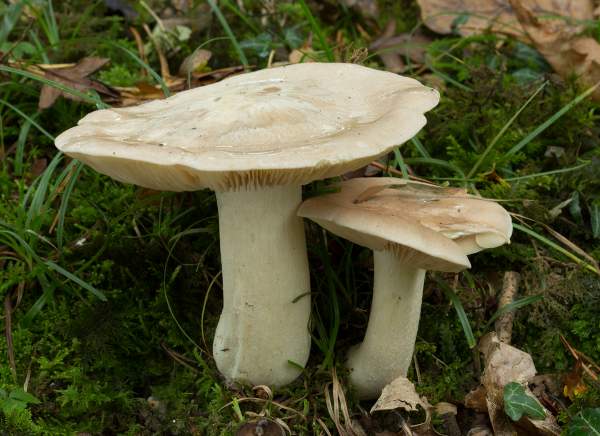
Culinary Notes
Unfortunately, not only is this abundant mushroom regarded as inedible but it may even be poisonous. In any case, who would want to eat soap?
Reference Sources
Fascinated by Fungi, 2nd Edition, Pat O'Reilly 2016, reprinted by Coch-y-bonddu Books in 2022.
Kibby, G (2013) The Genus Tricholoma in Britain, published by Geoffrey Kibby
Dictionary of the Fungi; Paul M. Kirk, Paul F. Cannon, David W. Minter and J. A. Stalpers; CABI, 2008
Taxonomic history and synonym information on these pages is drawn from many sources but in particular from the British Mycological Society's GB Checklist of Fungi.
Acknowledgements
This page includes pictures kindly contributed by David Kelly.
Fascinated by Fungi. Back by popular demand, Pat O'Reilly's best-selling 450-page hardback book is available now. The latest second edition was republished with a sparkling new cover design in September 2022 by Coch-y-Bonddu Books. Full details and copies are available from the publisher's online bookshop...
